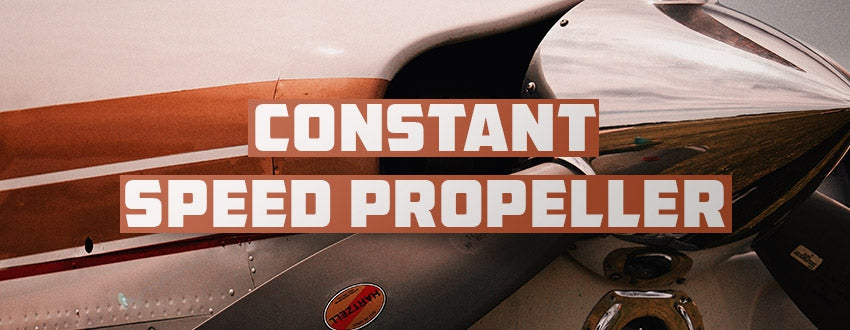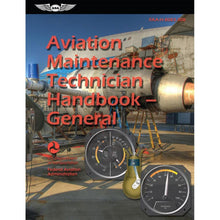Constant Speed Propeller: How Does it Work? (Basics)
A fixed pitch propeller does an okay job for takeoffs and a decent job for cruising while ground adjustable propellers force pilots to choose between maximizing either their climb performance or their cruise performance, but not both. At some point, many pilots say that “okay,” “decent,” and having to choose only one phase of flight whose performance to optimize are just not good enough. The solution is to choose a constant speed propeller.

Featured Pilot Gear
Browse our selection of high-quality pilot supplies! Your purchase directly supports our small business and helps us continue sharing valuable aviation content.
A fixed pitch propeller does an okay job for takeoffs and a decent job for cruising while ground adjustable propellers force pilots to choose between maximizing either their climb performance or their cruise performance, but not both.
At some point, many pilots say that “okay,” “decent,” and having to choose only one phase of flight whose performance to optimize are just not good enough. The solution is to choose a constant speed propeller.
 What is a Constant Speed Propeller?
What is a Constant Speed Propeller?
Constant speed propellers are a type of variable pitch propeller that maintains a constant rotational speed by automatically adjusting blade pitch.
They get the name constant speed because they can maintain a steady RPM while in flight. The name does not mean they are only able to operate at one specific and constant speed.
Purpose of a Constant Speed Propeller
The goal of a constant speed propeller is to hold the rotational speed steady at the engine’s optimum speed for a given situation regardless of the engine torque, altitude, or the plane’s airspeed. This stabilizing constant speed effect serves to improve fuel efficiency and maximize aircraft performance.
Since the optimum power for most engines is produced in a very narrow speed band, it would be difficult to keep the aircraft in that band manually.
By using a constant speed propeller much like a form of cruise control in a car, the RPM is automatically controlled and kept within the desired range.

(Constant Speed Propeller Diagram)
How a Constant Speed Propeller Works
Modern constant speed propellers work by automatically adjusting their pitch hydraulically, using a propeller governor or constant speed units and pressurized oil pumped through the propeller shaft. The pilot adjusts the pitch or propeller blade angle of a constant speed prop by moving the propeller lever.
Speeder Spring
When the pilot moves the prop lever, the attached governor control lever and threaded shaft move as well. As the shaft moves, it either applies or releases pressure on the speeder spring.
Pulling back on the lever increases the pitch of the blades as well as the corresponding torque requirement needed to hold a constant engine RPM.
In the absence of increased power, both the engine RPM and the prop speed will slow. This is the high pitch/low PRM propeller blade configuration, and it is generally used once you have reached your cruising altitude.
If the prop lever is pushed forward, blade pitch decreases, along with torque requirements needed for constant RPM. Keep power the same, and the engine RPM will increase. This configuration is a low pitch/high RPM set-up that is used for takeoff.
 Using a Constant Speed Propeller
Using a Constant Speed Propeller
Pulling the prop lever backward causes the threaded shaft to turn left and move up. This relieves the pressure on the speeder spring allowing centrifugal force to cause the flyweights to fly outwards and lift the pilot valve up. When the valve lifts, pressurized oil flows into the propeller hub.
The pressure of the oil forces the piston backwards and increases the blade angle. With the increased angle of attack, more engine torque is required to turn the propeller. The increased torque needs cause the engine’s RPM to decrease as the blade angle increases.
Flyweights
Pushing the prop lever forward causes the shaft to turn right and move down. The downward motion compresses the speeder spring and it in turn applies pressure to “L” shaped flyweights making them fall inward.
The weights lower a pilot valve which stops the flow of pressurized oil into the propeller hub and allows the oil to drain out into the oil sump. Without the pressure from the oil, the piston moves forward, and the blade angle decreases. This lowers the torque needs and the engine’s RPM increases.
Once a pilot has used the prop lever to set the desired RPM, the governor will make automatic adjustments to hold that RPM. If the aircraft enters a climb and no engine adjustments are made, as the plane pitches up, the engine will have to work harder, and its RPM will naturally drop.
As that happens, the fly weights will fall inward allowing the pilot valve to shift down and oil to flow out of the hub. The propeller blade pitch will reduce, less torque will be needed, and the engine’s RPM will increase and re-stabilize.
On the flip side, if the plane begins to descend, the engine will naturally speed up, and the centrifugal force will push the flyweights out. The pilot valve will raise sending oil into the hub, and the propeller blade pitch will increase. The engine will slow down and again stabilize at the set speed.
TIP: Within the hub, the oil is at a pressure of 300 psi compared to the 50 to 70 psi found in the engine. To keep from over pressurizing the cylinders, consider both throttle and propeller controls in tandem.
If you are moving the propeller control forward, remember to do that prior to throttling up and if you are pulling back on the propeller control, throttle down first.
 Takeaways
Takeaways
Constant speed propellers are a step up from fixed pitch or adjustable propellers because they help pilots to configure the aircraft for optimum performance and fuel economy during each stage of flight.
This system offers to the pilot the ability to select the proper propeller speed and engine setting they need. Constant speed propellers are easy to learn to use and can be a valuable tool for enhancing your flying experience.
Want to ensure your propeller blades stay in optimal condition? Keep track of inspection, maintenance, and repairs with an ASA Propeller Logbook.
Learn more about aircraft systems by checking out our Flight Training Material: Maintenance & Ownership collection.









